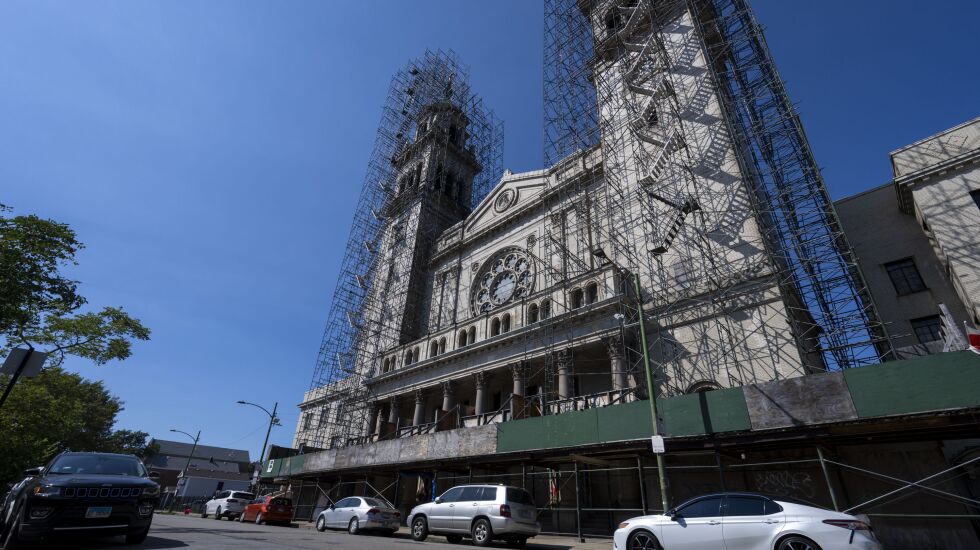
St. Adalbert and its twin 185-foot towers have welcomed worshippers and passersby to Pilsen since 1912.
The building closed in 2019 — its congregation was merged with that of nearby St. Paul’s — but the structure remains as a fine example of the richly-designed ecclesiastical works the city’s Roman Catholic archdiocese famously built during the 20th century.
St. Adalbert is a landmark in every sense of the word. Pilsen’s residents and former St. Adalbert parishioners knew this all along as they spoke up for the building while the archdiocese slowly stripped the valuables from the shuttered church’s interior.
And now the city’s landmark commission quite correctly recognized St. Adalbert’s importance last week by granting the edifice, at 1650 W. 17th St., preliminary landmark status during a special meeting.
“St. Adalbert has been a prominent feature of the Pilsen neighborhood for over a century,” the commission said.
Protection for the church — at least for now
The move keeps the archdiocese from demolishing the church while the city investigates whether permanent landmark status is warranted.
The preliminary designation would also prevent the archdiocese from picking apart the building’s interior or removing windows without having to first seek a permit for the work.
And the decision came in the nick of time. The special landmarks commission meeting was called after preservationists alerted the city that the church’s stained glass windows were being removed by work crews hired by Catholic officials.
An ornate rose window above the church entrance, an altar skylight and a series of windows throughout the nave were targeted for removal.
“Given the work … [was] initiated …without notice, the preliminary recommendation is moving forward to help ensure the complex’s significant features are preserved,” Planning Department spokesperson Peter Strazzabosco said in a statement.
For its part, the archdiocese said St. Paul decided to remove and “safeguard the stained glass” after some panes were destroyed by break-ins and vandalism.
Last fall, the archdiocese moved a marble replica of Michelangelo’s Madonna della Pieta from St. Adalbert to St. Paul, drawing protestors. The sculpture depicts Jesus’s body laying across his mother Mary’s lap after his crucifixion at Calvary.
The preliminary designation includes nearby St. Adalbert complex structures, such as the Bartolomé de Las Casas Elementary School. The commission’s decision also allows unused parts of the campus to be developed.
The archdiocese has tried unsuccessfully to sell the church since it was closed in a wave of parish consolidations four years ago.
“We don’t want it torn down,” said Raul Serrato, an ex- St. Adalbert member now attending St. Paul, who opposes the designation. “Once it’s landmarked, it really complicates what you can do with that property.”
Not just St. Adalbert
St. Adalbert is one of 115 parishes closed since 2018 under the archdiocese’s ongoing Renew My Church consolidation program created in response to falling Catholic Church membership numbers in the city and suburbs.
We admit the archdiocese faces a tough question: What to do with its growing portfolio of aging, emptying and expensive-to-maintain churches.
Serrato, who sits on the St. Paul finance committee, said it would cost about $4 million to repair St. Adalbert, with upkeep running around $20,000 a month.
The problem becomes even more complicated, considering the churches are among the city’s best architecture.
In addition to St. Adalbert, there are scores of others, including the 120-year-old former Corpus Christi Church, a stylish Italian Renaissance Revival edifice at 49th Street and King Drive. The worship space, which featured an intricate coffered ceiling, closed in 2021.
But the answer for these churches has to be better than padlocking the doors and letting workers, time and decay pick away at the building’s bones.
That means the preliminary landmark designation for St. Adalbert must also lead to a larger discussion with the archdiocese, the city and others that results in the preservation and reuse of these glorious buildings.
The Sun-Times welcomes letters to the editor and op-eds. See our guidelines.






